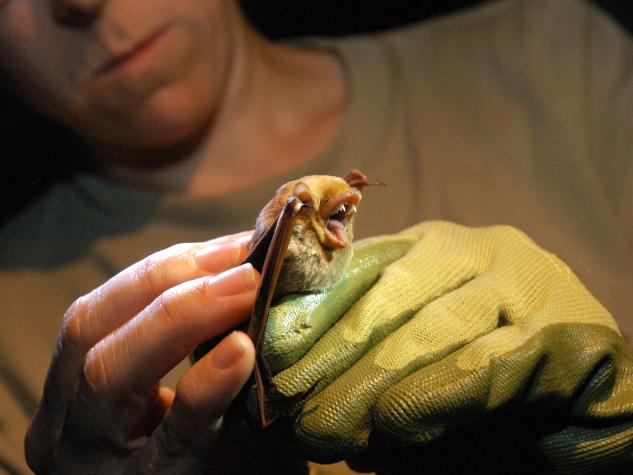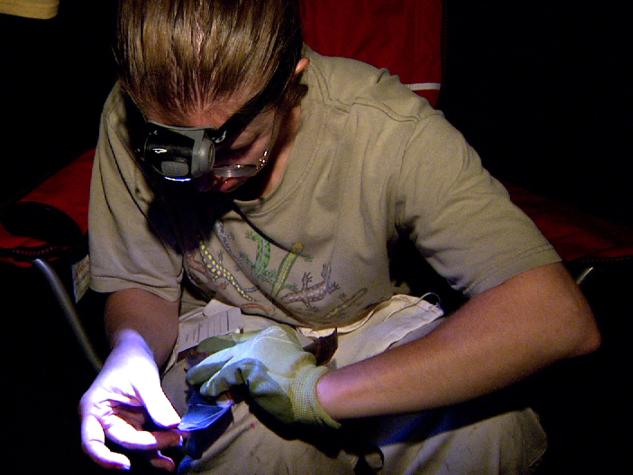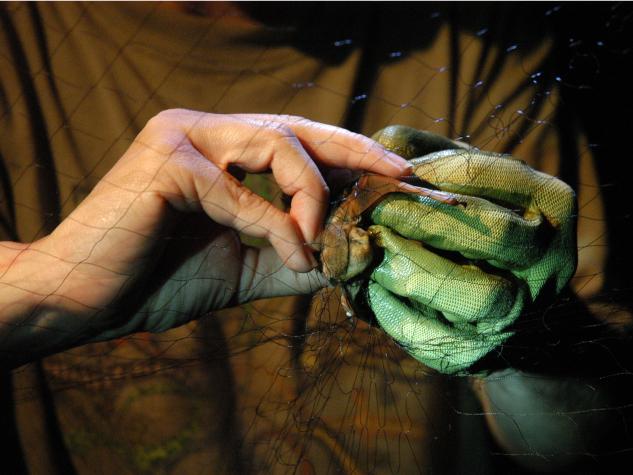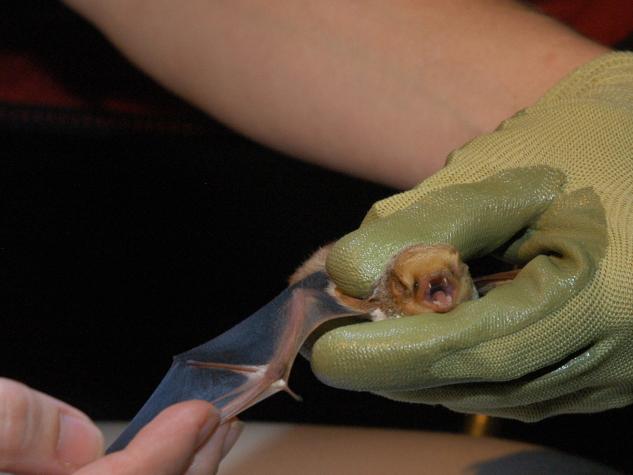Originally published Aug. 19, 2009.
WAPPAPELLO, Mo. – An intensive, three-night survey of the bat population on public lands in southeastern Missouri netted more than 600 bats, including representatives of several endangered, vulnerable or seldom-seen species.
About 80 participants, including professional biologists, students and dedicated amateurs, converged on the University of Missouri’s University Forest Environmental Education Center, which served as headquarters for the “Bat Blitz.”
“It’s a census of the different species of bat that are out here,” said Hank Stelzer, MU Extension forester and superintendent of the University Forest.
Bree McMurray, endangered species biologist for the Missouri Department of Transportation, said the 2009 Bat Blitz was “by far the most successful” of the eight annual surveys organized by the Southeastern Bat Diversity Network. This is the first year Missouri has hosted the event.
On three consecutive days, Aug. 10-12, caravans of pickup trucks left the University Forest before sunset to selected sites, some as far as 60 miles away, where teams set up “mist nets”—large, fine meshes suspended between tall aluminum poles.
“It’s kind of like Christmas morning for some people,” McMurray said on the first night of the Bat Blitz. “You spend maybe a couple days picking out sites, a couple hours setting your nets just right. You wait for dark and go to that net the first time and really hope there’s something in it.”
Her team set up three nets in clearings in woodland bordering a soybean field near Wappapello Dam. The knee-high soybean plants presented an expansive buffet for local wildlife, including two dozen or so deer, a handful of wild turkeys and innumerable insects. The idea was that bats emerging from their roosts in loose-barked trees would use the clearing as a corridor into the field, where the bats would feast on the bugs.
There was no doubt that the bats were out there. Bats navigate by echolocation, emitting ultrasonic squeaks and listening for the echoes to detect surrounding objects. McMurray aimed a hand-held sensor that picked up the squeaks and played them back at frequencies audible to humans.
Shortly after sunset her team caught its first bat, a male evening bat. Many others followed. By the end of the Bat Blitz, participants had recorded data—species, weight, sex and other characteristics—on 623 bats from about 35 different sites.
All sites were on public land managed by state or federal agencies, including the Missouri Department of Conservation, the Army Corps of Engineers, the Fish and Wildlife Service and the Forest Service. Because bats are shy, nocturnal and airborne, it’s hard to get a lot of good data about an area’s bat population. By pooling labor and resources, the Bat Blitz accomplished in three nights what normally might take months or even years for these agencies to undertake with local staff and funding.
Bat Blitz nets snagged 11 of 13 bat species known to live in southeastern Missouri, including big brown bats, red bats, eastern pipistrelles and representatives of two endangered species: the gray bat and Indiana bat.
The survey also found southeastern and Rafinesque big-eared bats—two species seldom seen in Missouri in the last two decades, said Sybill Amelon, research biologist for the U.S. Forest Service and postdoctoral associate at the MU College of Agriculture, Food and Natural Resources.
The data collected during the Bat Blitz is of more than scientific importance. Bats devour huge numbers of mosquitoes, beetles and other insects, consuming their body weight in bugs each night.
“A typical big brown bat can eat 3,000-7,000 mosquitoes in one night,” Stelzer said.
On farms, a colony of 150 big brown bats can eat almost 40,000 adult beetles during the growing season. By preventing those beetles from reproducing, that one colony has spared fields from about 18 million crop-devouring larvae.
If bats were to suddenly go away, these pests could devastate crops and expose people to vastly increased risk from insect-borne diseases such as West Nile virus.
In the eastern United States, bats are, in fact, going away. Hundreds of thousands of bats have died from white-nose syndrome, a mysterious disease linked to a fungal infection that flourishes as bats hibernate. Infected bats wake up from hibernation in the dead of winter. With few insects to feed on, they burn off their energy reserves and usually starve to death.
WNS was first noticed in New York state in 2006 and has since advanced as far as western Virginia. “We worry that it’s going to move down the Appalachians, swing west into the Mississippi Delta then come back up,” Stelzer said.
“We could be looking at losing 90 percent of hibernating bats in the next five years,” Amelon said.
The Bat Blitz has provided biologists with baseline data—what Stelzer calls a “snapshot” of the bat population at a particular time and place. If WNS reaches Missouri, this data will help biologists gauge what kind of effect the disease is having and guide the development of strategies to combat it, Amelon said.
###
For more information, visit the Southeastern Bat Diversity Network.
If you have found a bat in need of help, Sybill Amelon recommends Bat World Sanctuary for links to local resources. Never handle a bat barehanded.
Photos available for this release
Biologist Bree McMurray examines a red bat
Caption: Biologist Bree McMurray examines a red bat at the August 2009 Bat Blitz, Wappapello, Mo.
Credit: University of Missouri Extension
Biologist Bree McMurray examines a bat.
Caption: Biologist Bree McMurray examines a bat at the August 2009 Bat Blitz, Wappapello, Mo.
Credit: University of Missouri Extension
Bree McMurray removes a bat from a mist net
Caption: Bree McMurray removes a bat from a mist net.
Credit: University of Missouri Extension
Biologist Bree McMurray examines a red bat
Caption: Biologist Bree McMurray examines a red bat at the August 2009 Bat Blitz, Wappapello, Mo.
Credit: University of Missouri Extension



